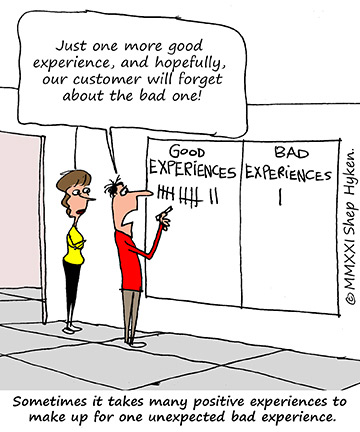The Unexpected Stands Out—Especially if it’s Bad
In the customer service world, people have expectations. They want to be treated with dignity and respect. They expect that if they buy something, it will work and do what it is supposed to. If it doesn't, they expect the company to stand behind its products and services.
The effort a customer makes to get the problem resolved—hopefully, it's minimal effort—is ideally rewarded with an acceptable and expected resolution. In other words, if there is a problem, customers expect it to be handled appropriately, and when it is, they are usually happy to continue doing business with you.
I share this because someone recently asked why bad experiences seem to always be remembered over good experiences. Great question, and here are my thoughts:
First, consider that the unexpected stands out, while the expected seldom gets noticed. And a good experience is always expected. So, when a customer receives a bad experience, it stands out, because it's unexpected. By the way, if there's an over-the-top amazing experience, that stands out, too. However, it is human nature to notice what hurts more than what feels good. The old saying comes to mind, "The squeaky wheel gets the oil."

There are plenty of stats and facts out there to support this. Way back in the 1980s, the Technical Assistance Research Program, also known as TARP, found that it takes six good customer service experiences to make up for one bad one. The number is even higher for businesses that have higher expectations, such as Disney, Ritz-Carlton, and other brands that have an excellent reputation for customer service.
Consider that number. If something great happens, the customer appreciates the company. If something bad happens, it becomes "judgment day" for that company. A customer could be happy with the company they do business with for years, then one day something bad happens. What happens after that is what makes or breaks the relationship. And, if that experience is managed the way it should be, it not only fixes the problem but also restores the customer's confidence in the company. That, by the way, is very important.
Customers will remember an unexpected positive customer experience, especially if it is a surprise. However, the negative experiences hurt. They cause a customer to question why they are doing business with a company. The customer may dread having to search for the company's phone number, wait on hold for a customer service rep, fear they will be transferred again and again ... you get the idea. There's a lot more anxiety and pain associated with the negative experience than the positive feelings felt by a pleasant surprise. So make sure you get back on track quickly—manage the problem and get back to positive experiences. Eventually, the bad experience will fade in the customer's memory.
Shep Hyken is a customer service expert, keynote speaker, and New York Times, bestselling business author. For information, contact 314-692-2200 or www.hyken.com. For information on The Customer Focus™ customer service training programs, go to www.thecustomerfocus.com. Follow on Twitter: @Hyken
(Copyright © MMXXI, Shep Hyken)
This article was republished with permission and originally appeared at Shep Hyken.



